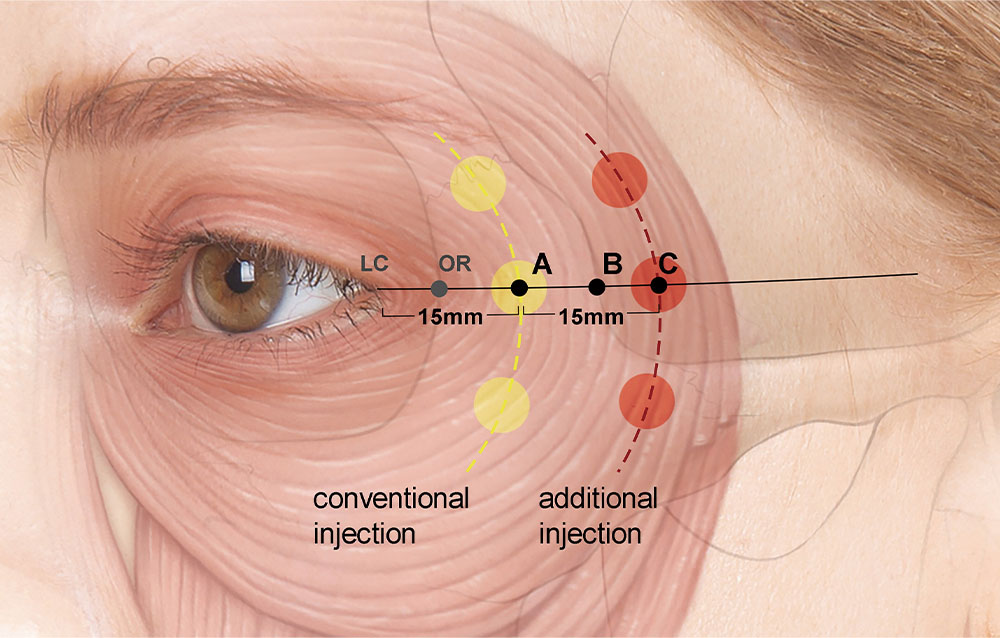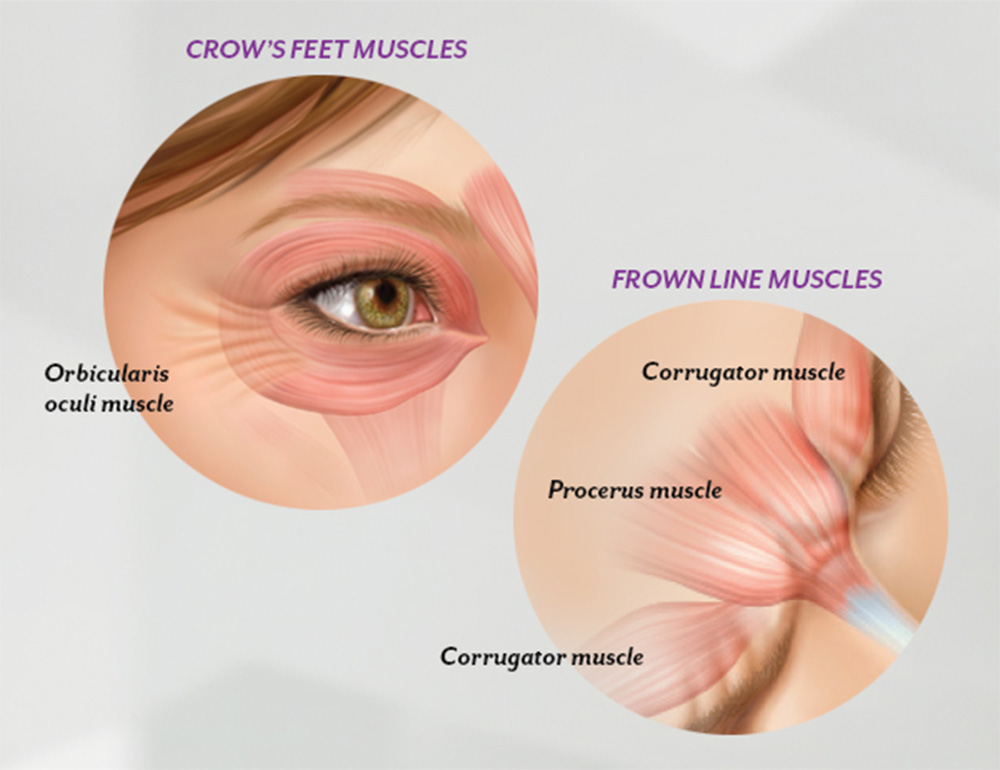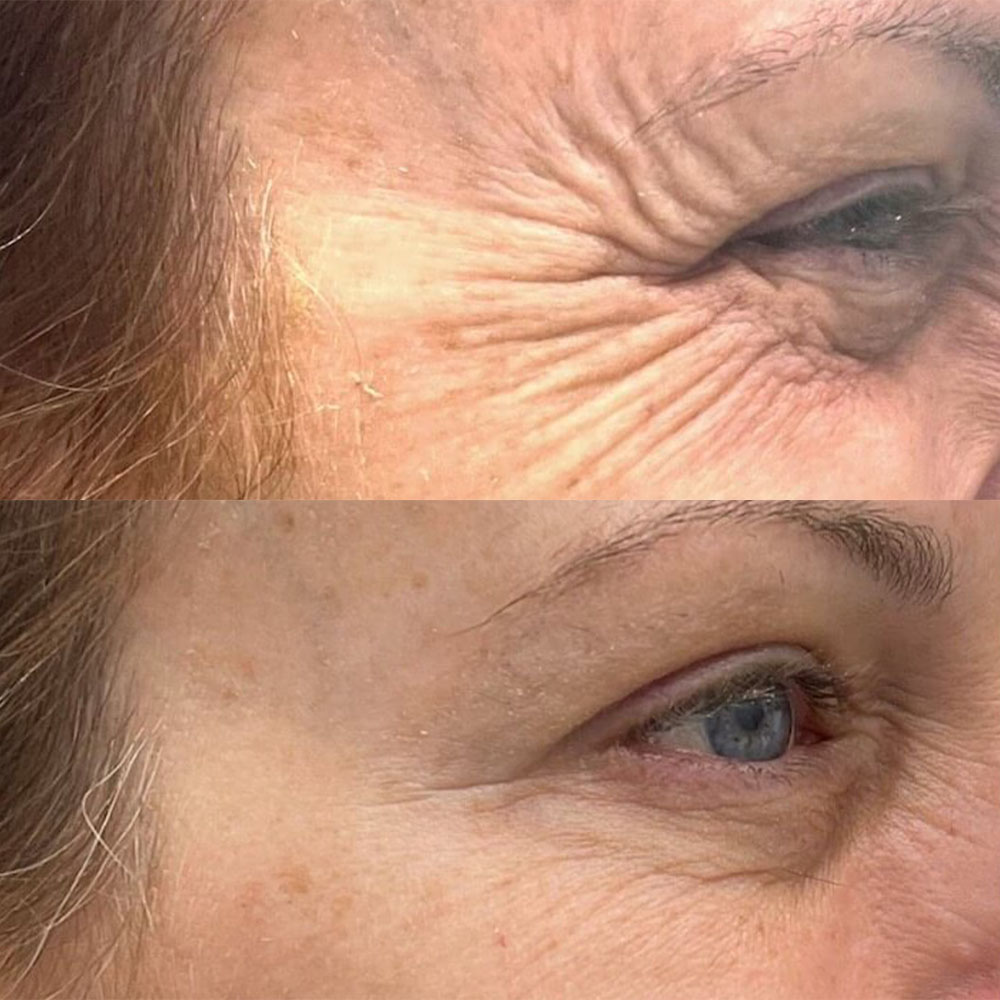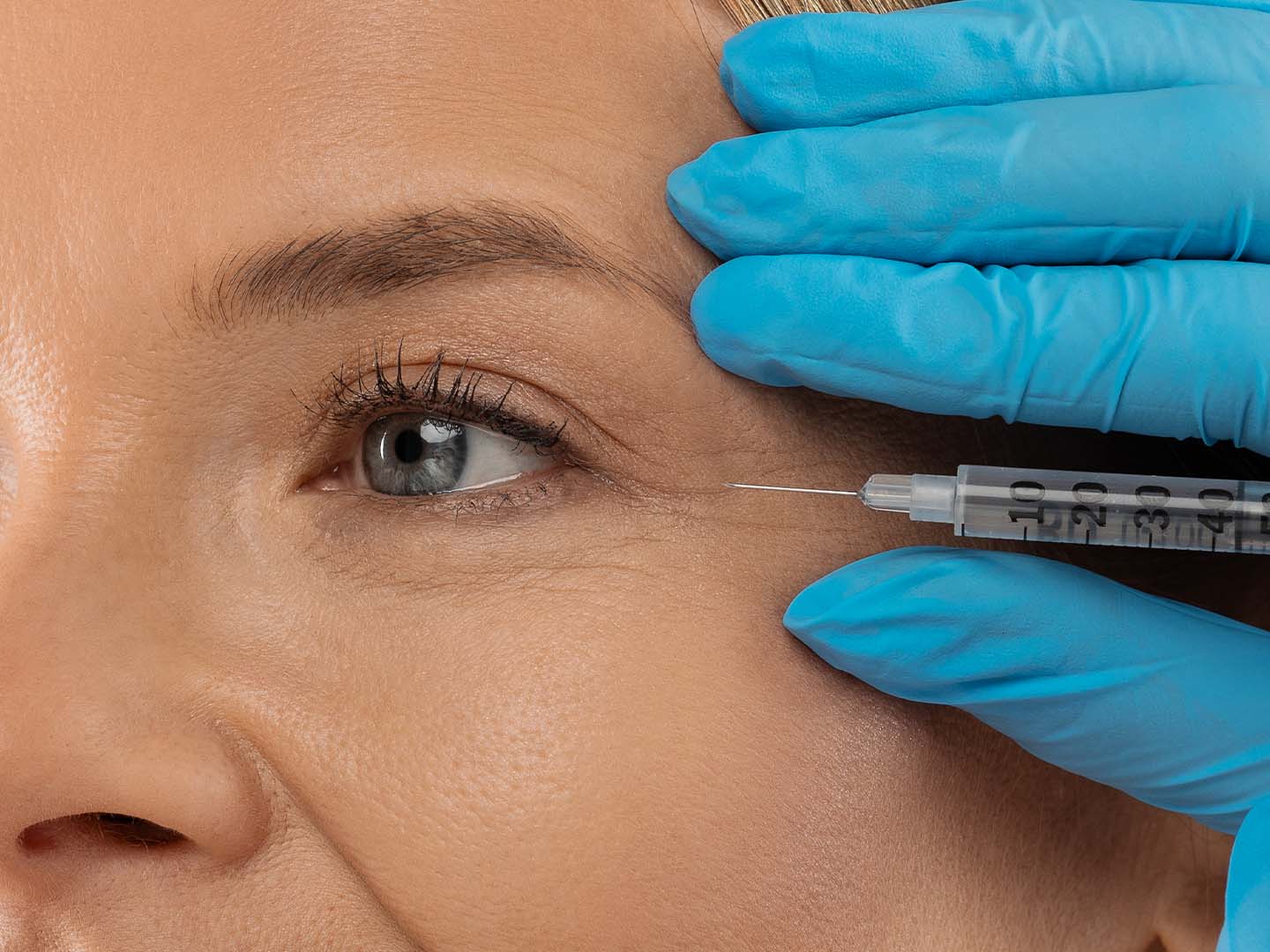
Crow’s feet, or lateral canthal lines, are among the first visible signs of aging, often appearing in the late 20s or early 30s. These fine lines around the eyes are primarily caused by repeated contractions of the orbicularis oculi muscle.
Among the many treatment options, Botox for crow’s feet remains the most popular and widely used. Compared to other aesthetic periocular techniques such as glabella Botox treatment, the crow’s feet area requires a more conservative and refined approach to avoid compromising natural expression.
Key Takeaways
- Botox is the gold standard for softening lateral canthal lines.
- Treatment works by relaxing the orbicularis oculi muscle.
- Dosing is conservative to preserve natural expression.
- Results last 3-4 months, with ongoing sessions recommended for maintenance.
- Safety and injector expertise are crucial to minimizing risks.
Why Botox for Crow’s Feet Is a Popular Choice
In consultations, patients frequently identify crow’s feet as their most bothersome age-related change. These lines, initially dynamic, deepen into static wrinkles over time if untreated. Because they are visible during smiling and social interactions, patients often feel they prematurely age the face.
Botox lateral canthal lines treatment offers predictable efficacy and an excellent safety record when administered properly. From a clinical standpoint, it is also versatile: dosing can be tailored to muscle bulk, skin quality, and aesthetic goals. Compared to surgical or filler interventions, Botox is minimally invasive, reversible, and relatively low-risk, making it an accessible option across patient demographics.

Anatomy Behind Crow’s Feet
A clear understanding of the orbicularis oculi muscle is critical before treating crow’s feet. This sphincteric muscle surrounds the eye and drives blinking, squinting, and smiling. Repetitive movement along the lateral canthus is the primary driver of crow’s feet formation.
Injectors must differentiate dynamic wrinkles (those visible with expression) from static wrinkles (present at rest). Neuromodulators like Botox target dynamic lines most effectively. Precise mapping of injection sites reduces the risk of diffusion into adjacent muscles such as the zygomaticus, which could affect smile symmetry.
Mechanism of Botox for Crow’s Feet
Botox inhibits acetylcholine release at the neuromuscular junction, inducing temporary relaxation of the orbicularis oculi. The result is a reduction in muscle contraction and softening of lateral canthal lines.
As a non-invasive Botox eye wrinkles treatment, it directly reduces the repetitive contractions that lead to fine lines while maintaining natural expression. For patients, explaining how Botox works for crow’s feet, by temporarily relaxing the orbicularis oculi, helps demystify the process and improve compliance.
In day-to-day practice, dosing in this region is lighter than in areas such as the forehead or glabella. Excess dosing risks creating an unnatural or “frozen” look, while conservative dosing maintains authentic facial animation. This balance is the key characteristic of advanced injection artistry and requires both anatomical knowledge and aesthetic judgment.

Injection Techniques and Dosage Protocols
Typical dosing ranges from 6-12 units per side, though this should always be individualized. Variables include gender, muscle thickness, degree of photodamage, and patient expectations. Injections are commonly placed at 3-4 points radiating laterally from the canthus, at least 1 cm away from the orbital rim.
In practice, injectors should evaluate patients dynamically, asking them to smile to map true muscle pull. Asymmetry is a common pitfall if one side is inadvertently overdosed or underdosed. Clinical documentation, including standardized photographs, is recommended for ongoing monitoring and for demonstrating crow’s feet Botox before and after outcomes.
Expected Results and Treatment Timeline
Patients often ask: “How soon will I see results?”
Setting realistic expectations is vital to long-term satisfaction. Botox offers subtle rejuvenation rather than complete wrinkle erasure:
- Onset of results: Improvements typically begin within 3-5 days post-injection.
- Peak effect: Most noticeable at 1-2 weeks, coinciding with patient follow-up appointments.
- Duration: Effects last about 3-4 months, though repeat treatments may extend benefits.
- Cumulative benefits: With regular sessions, partial retraining of the orbicularis oculi can provide progressively smoother outcomes.
- Outcome expectation: Expect softening of lines, not elimination, preserving natural eye expression.
- Maintenance: Most clinicians recommend scheduling repeat treatments 3-4 times per year for consistent results.

Side Effects of Botox for Crow’s Feet
Side effects are generally mild and short-lived. These include bruising, swelling, erythema, or tenderness at injection sites, resolving within a few days.
Rare complications such as eyelid ptosis or asymmetric smile occur if the product migrates into unintended muscles. These underscore the importance of anatomical precision and post-injection care. Practitioners should provide detailed aftercare instructions and schedule follow-ups to detect and address any issues early.
Safety Considerations for Crow’s Feet Botox Treatment
Patient safety is central to every procedure. A detailed history and examination are mandatory before treatment. Practitioners should consider the following:
- Contraindications: Pregnancy, breastfeeding, known hypersensitivity to botulinum toxin, or neuromuscular disorders such as myasthenia gravis.
- Active infections: Delay injections if a localized skin infection or inflammation is present.
- Systemic health: Review comorbidities and concurrent medications that may influence treatment safety.
- Medical history: Document prior experiences with Botox, complications, or hypersensitivity reactions.
- Patient counseling: Clarify risks, expected results, and alternative treatments. Informed consent is a critical ethical step.

Best Practices for Practitioners
Clinical experience consistently shows that conservative dosing provides the most natural results in periocular Botox. Using fewer units initially and titrating over time reduces the risk of overcorrection.
Patient education is equally important. Setting the expectation that Botox softens lines but does not eliminate them entirely helps avoid dissatisfaction. Follow-up visits allow for dose adjustments and strengthen practitioner-patient trust. Incorporating crow’s feet Botox before and after photos into consultations helps align goals and demonstrate treatment benefits.
Lastly
Botox for crow’s feet remains a safe, reliable, and effective treatment when performed by experienced injectors. With its ability to refresh the periocular area while preserving natural expression, it continues to be one of the most sought-after procedures in aesthetic medicine.
To further refine your clinical expertise, consider advancing your skills through aesthetic medical training for professionals and specialized Botox training. Mastery of periocular anatomy and complication management ensures consistently high-quality results.
FAQs
What are the riskiest areas for Botox?
Areas near muscles essential for eye or mouth function pose the greatest risk, such as periocular and perioral zones. For advanced risk management strategies, refer to the Botox Complications Masterclass.
Can Botox in crow’s feet affect smile?
Yes, diffusion into the zygomatic muscles may transiently alter smile dynamics. Careful placement and modest dosing significantly reduce this risk.
Is filler better than Botox for crow’s feet?
Botox is best suited for dynamic lines, while fillers may help address static, etched wrinkles. A combination approach is sometimes appropriate in patients with mixed wrinkle types.
Why do my eyes look weird after Botox?
Unnatural appearance often results from overdosing or misplacement of injections, leading to asymmetry. Experienced injectors minimize this by tailoring doses to facial anatomy and expression patterns.
How to sleep after crow’s feet Botox?
Patients should avoid lying face down, pressing on the periocular region, or engaging in strenuous activity for at least 4-6 hours post-treatment. Detailed recovery instructions are provided in professional Botox aftercare resources.
References:
- Carruthers A, Carruthers J, De Boulle K, Lowe NJ, Lee E, Brin MF. Treatment of crow’s feet lines and forehead lines with Botox (onabotulinumtoxinA): Development, insights, and impact. Medicine (Baltimore). 2023;102( Suppl 1):e32496. doi:10.1097/MD.0000000000032496. PMID: 37499083; PMCID: PMC10374187. https://pmc.ncbi.nlm.nih.gov/articles/PMC10374187/
- Baumann L, Dayan S, Connolly S, Silverberg N, Lei X, Drinkwater A, Gallagher CJ. Duration of clinical efficacy of onabotulinumtoxinA in crow’s feet lines: Results from two multicenter, randomized, controlled trials. Dermatol Surg. 2016;42(5):598-607. doi:10.1097/DSS.0000000000000757. PMID: 27110893; PMCID: PMC5414775. https://pmc.ncbi.nlm.nih.gov/articles/PMC5414775/
- Binder WJ. Long-term effects of botulinum toxin type A (Botox) on facial lines: A comparison in identical twins. Arch Facial Plast Surg. 2006;8(6):426-431. doi:10.1001/archfaci.8.6.426. https://www.liebertpub.com/abs/doi/10.1001/archfaci.8.6.426
- Cherney K. Is Botox effective for treating crow’s feet? Healthline. September 29, 2018. Updated September 29, 2018. https://www.healthline.com/health/botox-for-crows-feet
Disclaimer:
This article is intended for licensed medical professionals. All protocols, dosages, and treatment insights referenced herein are based on published literature. The content is not intended to encourage application, diagnosis, or self-treatment of unlicensed individuals, and should not be used as a substitute for the clinical judgment of a qualified healthcare provider.

